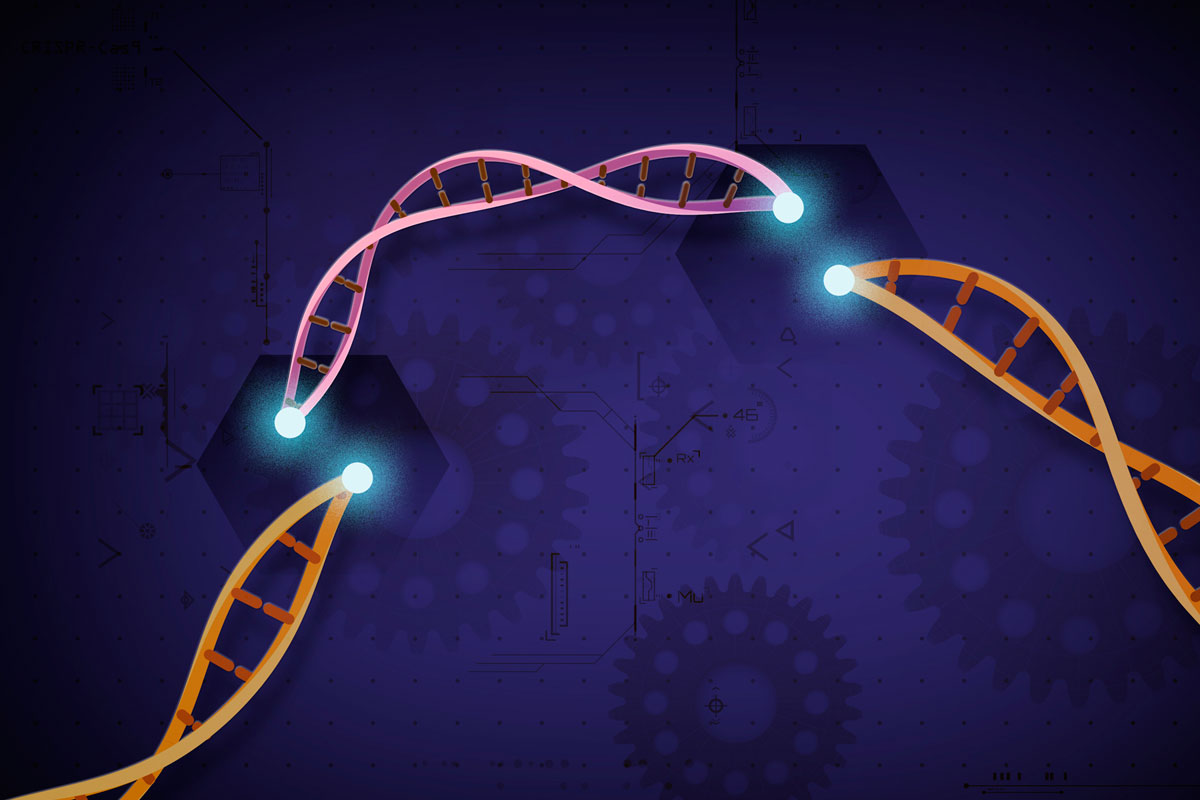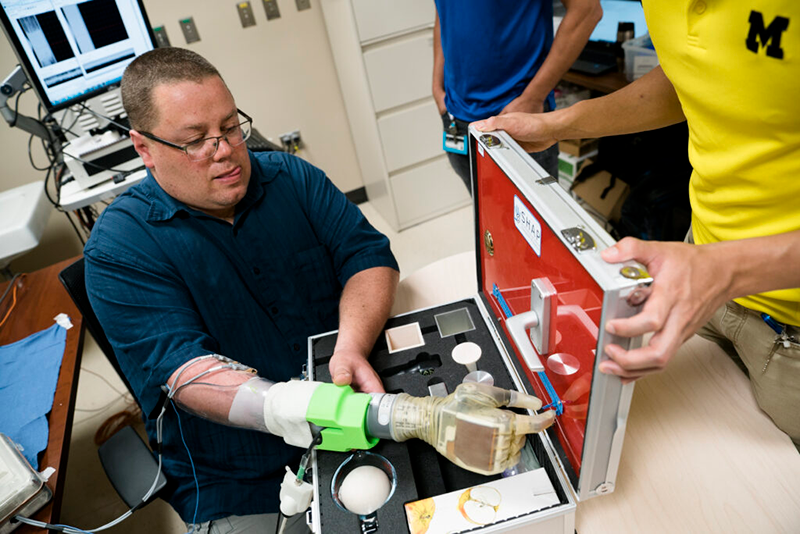The science of transhumanism
Are we nearly there?

Transhumanism looks to utilise science and technology to move humans beyond the limitations of their natural form. Recent scientific advances have, for the first time, presented plausible genetic interventions for the directed evolution of humans. In separate developments, electromechanical innovations, including miniaturisation of components and improvements in bio-compatible materials, have seen breakthroughs in brain-machine interfaces (BMIs) that potentiate a cybernetic dimension, in which mechanical devices would be under the direct control of the mind. This article offers insight into the most important of these recent advances, with particular emphasis on genome editing and therapeutic uses of BMIs in which the same technology might be employed for enhancement.
Keywords: augmentation, brain-machine interface, CRISPR, cyborg, genome editing.
What began as a relatively fringe movement to develop humans beyond the natural constraints of the species Homo sapiens has, in recent years, become much more mainstream. This shift is, in no small part, attributable to the emergence of technologies that begin to make it feasible to change the human form in ways that would be unlikely or impossible via «blind» evolution. Fundamentally, there are two dimensions in which the human form could be altered by science: the human-animal (biological) and the human-machine (electromechanical). Each of these will be considered in turn, beginning with the biological.
Biological routes to human enhancement
Genetics plays a pivotal role in our lives. We will not review the history of attempts to purposefully steer the genetic make-up of individuals but it is necessary to mention two approaches, if only to highlight their limitations. Firstly, it is more than 30 years since the pioneering use of pre-implantation genetic diagnosis (PGD) to select for embryos shown to be free from a known heritable mutation, potentially in combination with additional characteristic that would make them suitable future donors of stem cells for the treatment of a sick sibling. Although the term designer baby has been widely used for children born via PGD, it was never an especially accurate description, since the process was merely choosing combination of genes that were brought together naturally; it was never capable of the intentional introduction of novel genes.
A further step towards deliberate alteration of an individual’s DNA came in the form of a second technology, gene therapy. The aim of this strategy was to overcome diseases arising from possession of two faulty copies of a gene by addition of a further, functional copy. Although this sounds relatively straightforward, the reality proved more complex to control than had been hoped. For example, the very process of integrating the new DNA into an existing chromosome (in order to facilitate stable inheritance of the extra gene) could cause additional damage and lead to further problems. Given such limitations, the scope of this approach was always likely to be restricted to therapy rather than human enhancement.
The real ability to introduce additional capabilities into human via their genomes comes with the emergence of the CRISPR system, or more formally CRISPR-Cas9, for genome editing. Some success at altering genomes of other species had previously been achieved using tools known as zinc-finger nucleases (ZFNs) and transcription activator-like effector nuclease (TALENs) (Gaj et al., 2013). However, although use of CRISPR is not trivial, ZFNs and TALENs are considerably more complicated, expensive and inefficient, therefore they quickly dropped out of the race to enhance humans once the latter method was identified.
«The emergence of new technologies is beginning to make it feasible to change the human form in ways that would be unlikely or impossible via “blind” evolution»
It is no exaggeration to call CRISPR a game-changer; it opens up inheritable alterations to humans and give plausibility to the notion of the biological transhuman, and genuinely designer babies.
A crucial dimension in the application of CRISPR is the recognition that it can be used to cause double-stranded DNA breaks at a pre-determined point within almost any genome (CRISPR was originally identified as a defence mechanism in bacteria, in which the DNA of invading viruses, as a bacteriophage, is recognised in a sequence-specific way). A molecule of RNA is used to target a DNA-cleaving enzyme called Cas9 (CRISPR-associated protein number 9) to the position within a chromosome where you have decided to introduce a cut. Importantly, the fact that you only need to design a short RNA molecule to alter the location of the DNA break rather than rebuild the enzyme itself is a crucial factor that distinguishes CRISPR-Cas9 from both ZFNs and TALENs. The contrast is equivalent in complexity to changing the music you are listening to by putting in a different CD rather than re-constructing your HiFi from scratch.
Making a double-strand break in a cell’s DNA is a serious threat to its ongoing viability. If cleaving the DNA was the end of the story (as it would be for bacteria defending themselves against viruses) then this offers no potential for introducing novel genes. To do so requires subversion of the cell’s repair systems. Since several processes can naturally contribute to breakage of DNA, the body has systems that are activated to mitigate the damage. One of these mechanism involves homologous recombination (HR), also called homology-directed repair. HR takes advantage of the fact that we have two sets of our chromosomes and orchestrates restoration of the damaged sequence by copying the equivalent section from the other chromosome. To intentionally change or introduce an entirely different gene, as would be necessary for enhancement, the repair mechanism needs to be offered a rival template which it can be tricked into using rather than the second natural copy.
Researchers around the world are employing CRISPR and related methods to modify diverse organisms. CRISPR has also been used extensively with human cells. Usually this work is conducted in cultured cell lines, both for basic research purposes and, where there is an expectation of therapeutic use, to allow for appropriate checks to be made before any consideration of transferring those cells into a patient (Wang et al., 2014). These applications have demonstrated beyond doubt that the CRISPR system works. Nevertheless, significant causes for caution remain. You can, for example, end up with mosaicism: a mixed population of cells in which both copies of a gene have been changed, some in which one has been changed and one not, and others where no changes have occurred. There are also potential issues with «off-target effects» in which Cas9 cuts the DNA at wrong locations, causing unintended alterations within the genome.
Refinements of the standard CRISPR method that reduce some of these undesirable characteristics are in development. For example, mutations have been engineered into Cas9 which exploit the sequence-specific targeting of the CRISPR-Cas system, but restrict cleavage to one strand of the DNA (a much less risky scenario) whilst introducing novel capacities to change the DNA (Platt, 2019).
«Invasive alterations can involve direct interaction of an electromechanical device with the recipient’s central nervous system»
Despite the prevailing weaknesses, CRISPR has already been employed to alter the heritable human genome on at least one occasion. In November 2018, Dr He Jiankui announced that he had genetically modify twin girls, altering a protein called CCR5 which is exploited by HIV to enter cells. He used CRISPR-Cas9 to alter the gene for CCR5 in the girls, introducing a mutation that made a non-functional version of that protein and ought therefore to protect them against the virus.
The implantation of a genetically-modified embryo into a woman’s uterus remains illegal around the globe. The international science community and bioethicists, therefore, felt He Jiankui had been premature in crossing this Rubicon. The Chinese authorities agreed, sentencing him to three years in prison (Regalado, 2019). Although this is the first known example where someone has intentionally modified the hereditable human genome, the simplicity of CRISPR makes it highly plausible that attempts to perform other genetic alterations are already underway somewhere in the world.
Is this a mechanism for creating transhumans? Perhaps not initially, but the CRISPR-Cas9 system and related technologies have the potential not only to tinker with existing human genes, but to deliver genes derived from other organisms, or even entirely artificial sequences. Apart from certain size limitations it ought, in principle, to be possible to integrate any gene into the recipient’s genome once the targeted breakage has been generated. Novel attributes could be introduced, including radical augmentations, a term used to define literally super-human changes (e.g., the capability to fly) beyond the extraordinary augmentations, that is the capacity to perform some routine human task unnaturally well (for example, being able to run at 40 mph) (Shook & Giordano, 2016).

Cochlear implants overcome deficiencies in the normal acoustic hearing process by passing electrical signals directly to the auditory nerve. In the picture, a man with a cochlear implant is running the New York marathon. / David Shankbone
If something was not achievable in one round of changes, it might be possible to carry out several steps to incrementally add more alterations. This has already being done for the «humanisation» of pig organs to make them less likely to trigger rejection when transplanted into a human recipient (Begley, 2017). Lessons learnt during this process can inform future attempts to directly alter the human genome. It is also worth noting that, with an appropriate combination of guide RNA and DNA templates, it would be possible for CRISPR to alter multiple genes simultaneously. Clearly, however, the issues of potential mosaicism are significantly increased if the only acceptable outcome is the correct editing at several loci at the same time.
Electromechanical routes to human enhancement
Turning to the second dimension of development, let us consider the state of play regarding electromechanical interventions. Here we can draw a distinction between non-invasive approaches, that is to say those that remain external to the body, and those than involve literally getting under the skin (invasive). As should be self-evident, non-invasive approaches represent the «shallow end» of the human-machine spectrum. Many would not consider these to be truly transhumanist, but they serve at minimum to alert us regarding the extent to which technology already play a part in our biological lives. Examples would include the use of wearable devices such as Fitbits to record biometric data that influence our subsequent lifestyle choices. A step on from this would be the elective use of electrical brain stimulation methods such as transcranial magnetic stimulation (TMS) and transcranial direct current stimulation (tDCS) to improve mood, memory or language acquisition (Yazdi, 2020).
Switching focus to invasive alterations inevitably represents the crossing of a significant ideological, as well as physical, threshold. On one level, placing technology within the body runs the potential risk of infection, but this also represents a deeper commitment to change. Insertion of radio-frequency identification (RFID) chips that can communicate with external gadgets, store PIN numbers and other electronic information, or trigger the opening of doors have tangible benefits, e.g., for the physically disabled. However, there is also a community of body modification enthusiasts (grinder biohackers) who simply want to push the boundaries of human experience. For example, magnets are most likely to be incorporated to allow the wearer to have heightened experience of magnetic fields for sensual rather than medical reasons.
Getting wired up
A further incremental step is taken when invasive alterations involve direct interaction of an electromechanical device with the recipient’s central nervous system (CNS). This might involve connection via the spine, via a peripheral nerve, or directly with the brain. Such neural interfaces are not just the subject of future scenarios. Cochlear implants already overcome deficiencies in the normal acoustic hearing process by passing electrical signals directly to the auditory nerve, and deep brain stimulation, for example to treat disorders of movement, involves impulses being sent to electrodes implanted in the brain.
In the context of transhumanism, significant developments involve the control of neural prosthetic limbs, and broader aspects of brain-machine interfaces (BMIs). As with the previous innovations, therapeutic applications currently predominate, but it is easy to see how advances in prosthetics could be utilised for human enhancement. In one ground-breaking study, electrodes were implanted into the primary motor cortex of a tetraplegic woman (Collinger et al., 2013). Via cables connected to her skull, she was able to operate a prosthetic limb merely by thinking about the intended movement.

Recently, there have been significant advances in prosthetic limb control and broader aspects of brain-machine interfaces. Pictured here is a prosthetic limb developed at the University of Michigan (USA). Researchers harnessed the weak latent signals from the nerves in the arm and amplified them to enable intuitive, real-time control of the robotic hand./ University of Michigan
Elsewhere, researchers have been working on haptic devices that pass sensory information such as touch, pressure, and limb position to the brain via intracortical microstimulation. In one study, a man with a spinal injury was asked to describe the senses he experienced (albeit phantom) with a combination of stimuli delivered via electrodes implanted into his primary somatosensory cortex (S1) (Salas et al., 2018). A second team achieved limited sensation of touch and pressure in the brain of a paralysed man, when they wired a robotic hand to his S1 region (Flesher et al., 2016). The ultimate ambition of such studies is to achieve a closed-loop, i.e., bidirectional system, combining both the sensory input information and the motor response. This would allow for the «evolution» of fine motor skills.
It is worth reiterating that, up to this point, research has focused on rehabilitation. The fact, however, that much of the funding for such work has come from the US Defence Advancement Research Project Agency is an indicator that innovations of this kind have tangible potential for enhancement purposes, for example the control of super-human limbs for super-soldiers.
Broader advances regarding BMIs include «augmented cognition», enabling someone to access remote computing facilities directly from one’s mind. This might allow them to conduct complex mathematical calculations «in their head», or grant enhanced perception of their surroundings, with the capacity to be routinely archiving the gathered data (Roelfsema, Denys, & Klink, 2018). Alternatively, it may be possible to download instant linguistic fluency or the ability to perform some task.
Development of BMIs is not only reliant on understanding of the mind, but also upon cybernetic innovations. These includes improvement to the speed of information transfer (Lebedev, Opris, & Casanova, 2018), as well as advances in material science to deliver stable and effective connection between the organic wetware of the brain and the technological hardware.
Experience with existing brain implants has highlighted a number of obstacles that will need to be overcome. These include: damage of tissues around electrodes, degradation of the electrodes themselves, loss of signal due to micro-shifting of the connections at the interface, and the triggering of immune responses (Polikov, Tresco, & Reichert, 2005). Biocompatibility and longevity of electrodes is a crucial priority. The stability, dimensions and carbon-based nature of graphene nanotubes, make them particular attractive for a range of biomedical applications, including for BMIs (Rauti et al., 2019).
The development of brain-machine interfaces is an area of active interest for entrepreneur Elon Musk (Waldert, 2016). His Neuralink company is one of several organisations reported to be close to human trials of BMIs. Miniaturisation has been a top priority, with the threads into which electrodes for Neuralink’s BMI are bundled apparently so small that a specialist robot is needed to position them within a recipient’s brain whilst avoiding damage to blood vessels. Critics have argued that the timeline being promoted by Musk is unrealistic, and that he is not taking sufficient note of fundamental difficulties, such as the unique architecture of every person’s brain (Corbyn, 2019).

In the picture, the artist Neil Harbisson, who was born with achromatopsia, a visual deficit that caused him to perceive the world in grey. In 2004, he was implanted with an antenna that allows him to convert light waves to sound frequencies. Harbisson defends the right of individuals to incorporate robotics into the human body and to design themselves as a species./ Flávia de Quadros / indicefoto.com / Campus Party Brasil
Any advances in these areas would clearly bolster the innovations discussed previously regarding the operation of «smart» prosthetic limbs, but Musk is transparent about his desire to go beyond therapeutic applications and to achieve symbiosis with AI. In this regard, a stable and effective BMI is the gateway to creation of full-blown cyborgs in which the brain is the only remaining organic remnant of a once-human individual. Musk also pictures a world in which you would have the capacity to archive versions of your memory in the same way you might save versions of a document. It needs to be reiterated that this is not yet feasible, but the science that might achieve this is definitely advancing.
Others would seek to go even further: to sever any link to the organic self and essentially upload the human mind onto computers as a «whole brain emulation» (Tirosh-Samuelson, 2018). Although such a being would no longer have any biological matter, it would be posthuman, there would nevertheless have been a time when those thoughts and memories were tied to a physical person. This stands in contrast with an android, a «being» that remains entirely machine, but manifesting human characteristics.
Cyborgs… what about androids?
Although the terms are sometimes used as though they were interchangeable, cyborgs and androids are in fact different entities, with the latter being entirely artificial, anthropomorphic robots. Several recent developments have seen growing calls for androids to be granted personhood. For example, in 2017 Saudi Arabia awarded citizenship to a robot called Sophia and the European Parliament has debated allocation of liability should a company’s robot be found responsible for any damage to the property of others (Giger et al., 2019).
Since an android has never existed in an embodied, biological form it is inevitably, to some measure, a fake human, not a trans- or even a post-human. I therefore consider such a being to fall outside the scope of our present survey.
Conclusion
Predicting the time-frame and significance of innovations is famously problematic. Amara’s Law (as cited in Brooks, 2017, p. 79) posits that «we tend to overestimate the effect of a technology in the short run and underestimate the effect in the long run». The goals of transhumanism have not yet been achieved. However, recent developments in fields as diverse as brain-machine interfaces and in genome editing have moved unexpectedly fast and offer the strongest indications yet that evolution beyond the natural constraints of Homo sapiens is feasible.
References
Begley, S. (2017, August 10). Birth of CRISPR’d pigs advances hopes for turning swine into organ donors. STAT. https://www.statnews.com/2017/08/10/crispr-pigs-organ-transplant
Brooks, R. (2017). The seven deadly sins of AI predictions. MIT Technology Review, 120(6), 79–86. https://www.technologyreview.com/2017/10/06/241837/the-seven-deadly-sins-of-ai-predictions
Collinger, J. L., Wodlinger, B., Downey, J. E., Wang, W., Tyler-Kabara, E. C., Weber, D. J., McMorland, A. J. C., Velliste, M., Boninger, M. L., & Schwartz, A. B. (2013). High-performance neuroprosthetic control by an individual with tetraplegia. The Lancet, 381(9866), 557–564. https://doi.org/10.1016/S0140-6736(12)61816-9
Corbyn, Z. (2019, September 22). Are brain implants the future of thinking? The Guardian. https://www.theguardian.com/science/2019/sep/22/brain-computer-interface-implants-neuralink-braingate-elon-musk
Flesher, S. N., Collinger, J. L., Foldes, S. T., Weiss, J. M., Downey, J. E., Tyler-Kabara, E. C., Bensmaia, S. J., Schwartz, A. B., Boninger, M. L., & Gaunt, R. A. (2016). Intracortical microstimulation of human somatosensory cortex. Science Translational Medicine, 8(361), 361ra141. https://doi.org/10.1126/scitranslmed.aaf8083
Gaj, T., Gersbach, C. A., & Barbas III, C. F. (2013). ZFN, TALEN, and CRISPR/Cas-based methods for genome engineering. Trends in Biotechnology, 31(7), 397–405. https://doi.org/10.1016/j.tibtech.2013.04.004
Giger, J. C., Piçarra, N., Alves‐Oliveira, P., Oliveira, R., & Arriaga, P. (2019). Humanization of robots: Is it really such a good idea? Human Behavior and Emerging Technologies, 1(2), 111–123. https://doi.org/10.1002/hbe2.147
Lebedev, M. A., Opris, I., & Casanova, M. F. (2018). Augmentation of brain function: Facts, fiction and controversy. Frontiers in Systems Neuroscience, 12, 45. https://doi.org/10.3389/fnsys.2018.00045
Platt, R. J. (2019). CRISPR tool enables precise genome editing. Nature, 576, 48–49. https://doi.org/10.1038/d41586-019-03392-9
Polikov, V. S., Tresco, P. A., & Reichert, W. M. (2005). Response of brain tissue to chronically implanted neural electrodes. Journal of Neuroscience Methods, 148(1), 1–18. https://doi.org/10.1016/j.jneumeth.2005.08.015
Rauti, R., Musto, M., Bosi, S., Prato, M. & Ballerini, L. (2019). Properties and behavior of carbon nanomaterials when interfacing neuronal cells: How far have we come? Carbon, 143, 430–446. https://doi.org/10.1016/j.carbon.2018.11.026
Regalado, A. (2019, December 30). He Jiankui faces three years in prison for CRISPR babies. MIT Technology Review. https://www.technologyreview.com/2019/12/30/131061/he-jiankui-sentenced-to-three-years-in-prison-for-crispr-babies
Roelfsema, R., Denys, D., & Klink, P. C. (2018). Mind reading and writing: The future of neurotechnology. Trends in Cognitive Sciences, 22(7), 598–610. https://doi.org/10.1016/j.tics.2018.04.001
Salas, M. A., Bashford, L., Kellis, S., Jafari, M., Jo, H. C., Kramer, D., Shanfield, K., Pejsa, K., Lee, B., Liu, C. Y., & Andersen, R. A. (2018). Proprioceptive and cutaneous sensations in humans elicited by intracortical microstimulation. eLife, 7, e32904. https://doi.org/10.7554/eLife.32904
Shook, J. R., & Giordano, J. (2016). Neuroethics beyond normal: Performance enablement and self-transformative technologies. Cambridge Quarterly of Healthcare Ethics, 25(1), 121–140. https://doi.org/10.1017/S0963180115000377
Tirosh-Samuelson, H. (2018). In pursuit of perfection: The misguided transhumanist vision. Theology and Science, 16(2), 200–222. https://doi.org/10.1080/14746700.2018.1463659
Waldert, S. (2016). Invasive vs. non-invasive neuronal signals for brain-machine interfaces: Will one prevail? Frontiers in Neuroscience, 10, 295. https://doi.org/10.3389/fnins.2016.00295
Wang, T., Wei, J. J., Sabatini, D. M., & Lander, E. S. (2014). Genetic screens in human cells using the CRISPR-Cas9 system. Science, 343(6166), 80–84. https://doi.org/10.1126/science.1246981
Yazdi, P. (2020, September 22). 13 effects of transcranial direct current stimulation (tDCS). SelfHacked. https://selfhacked.com/blog/tdcs-benefits





